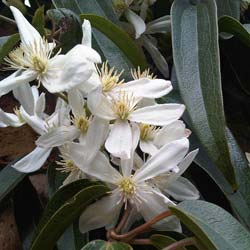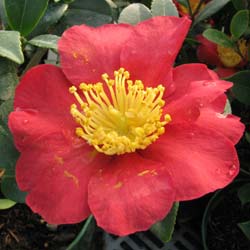|
|
Advices for the ficus benjamina
Habitat
Put your ficus in a well lighted place, not in the direct sun light, and sheltered from drafts. It appreciates the reasonably heated rooms.
Watering
Avoid watering too much. Wait that the surface of substrate is drained. If you water too much or too often, roots rot but you can't realise that. When damages apperar (wilting then fall of leaves), it is often too late to treat the plant.
Use if possible a non-calcareous water. Let it rest 24 - 48 hours if you get it from the tap, to eliminate the chlorine. The rainwater is the softest. Use some water at the temperature of the room and just pour the quantity which the earth absorbs. Avoid the formation of stagnant water.
As other green plants, supplement humidity contribution by atomising its leaves.
Dusting
the dust, by settling on leaves, prevents them from breathing and from picking up the light which they need to bloom. Clean leaves with a humid sponge (and rinsed well) or a paper towel leaf folded in four and soaked. There are some products specific for the maintenance of the green plants. A water and milk mixture or of beer is suitable too ! Pass slowly on leaves, from the peduncle towards the tip.
Fertilizer
Liquid fertilizer every 15 days in spring, or in sticks 3 times a year.
Fall of leaves and other symptoms:
 If it is normal that a part of the foliage falls every year, the fall of green leaves reveals a weakness. Several factors can go together such as a brusque variation of the temperature, a deficient or excessive watering, a displacement of the young plant, a too weak brightness or an attack of parasites, the most frequent animals being tetranychus (red spiders) and cochineal insects. If it is normal that a part of the foliage falls every year, the fall of green leaves reveals a weakness. Several factors can go together such as a brusque variation of the temperature, a deficient or excessive watering, a displacement of the young plant, a too weak brightness or an attack of parasites, the most frequent animals being tetranychus (red spiders) and cochineal insects.
If leaves turn yellow too often, an attack of tetranychus is suspected. Tiny whitish patches appear on leaves and a small spider web forms in the axil of the petiole (or leafstalk) and of the leaf. These undesirable insects like the hot and dry places. Move away your ficus off the sources of heat and atomise it. If it is not enough, deal then with an acaricide sold in specialised shops.
Camphor Scale betray themselves by the presence, on leaves, stems and trunk, of a white matter and fleecy. While obscure mealybug (Pseudococcus viburni) deposit a sticky honeydew on leaves. It is possible to evict the first ones by brushing the trunk and the contaminated branches, or by applying delicately, with the aid of a cotton-stem, some alcohol on places showing symptoms. For the seconds, only a treatment with a special product will be able to overcome it.
To pass the winter:
the ficus accepts a temperature of 15°C! 22°C would be harmful.
Put your ficus far from a radiator or from a fire. If the ambient air is dry, atomise the foliage or instal a humidifier.
Beware if you leave some days on holiday: the temperature of the room should not go down too much. Your green plants support well 2 or 3 days in the dark but no low temperature.
In periods of low temperatures, it should not cause cold spells to your plants. Do not place your ficus too near a window that you open, even a few minutes to ventilate the room. Beware of frosted glass, the cold radiates far!
Over the years
If properly treated, the ficus can take beautiful proportions (2-4 meters). Instead of a potting quite tedious, replace the topsoil, which is soon exhausted.
Finally, if you can, do not hesitate to put it in the garden from April to October: This will greatly benefit from its foliage.
|
other advice:
- planting
- pruning
- fruit trees
- maintenance
- ficus
|
|
How to reproduce a ficus:
- Cutting:
Cut the top of the ficus, put it in the water, then in full earth. During this delicate stage, the stem risks losing all its leaves, or drying out by evaporation, because its leaves are rather broad.
- Air layering:
Lead a stem, still on foot, to fabricate roots, what the ficus can make naturally when it is old. Choose an important and healthy stem located near the top of the young plant. With a knife, make an incision on the bias on 1/3 - 1/2 of the thickness of the stem. A match into the incision is slipped to prevent it from closing again. Apply to the margins of the cut of the hormone powder. Make a mixture composed of 1/2 of the sphagnum foam and 1/2 of the humus that they take care of dampening well. The incision with this substrate is enveloped so as to form a bowl of the size of a tennis ball. It is necessary to keep humidity for example by enveloping the mass of a plastic bag that is closed with a twine. Roots should appear after about two months. Then remove the plastic, then cut the end of the stem, just below the new roots. Finally, plant the stem with the sphagnum bowl in a pot filled with a a suitable substrate for the ficus.
|

![]()

![]()

![]()
 If it is normal that a part of the foliage falls every year, the fall of green leaves reveals a weakness. Several factors can go together such as a brusque variation of the temperature, a deficient or excessive watering, a displacement of the young plant, a too weak brightness or an attack of parasites, the most frequent animals being tetranychus (red spiders) and cochineal insects.
If it is normal that a part of the foliage falls every year, the fall of green leaves reveals a weakness. Several factors can go together such as a brusque variation of the temperature, a deficient or excessive watering, a displacement of the young plant, a too weak brightness or an attack of parasites, the most frequent animals being tetranychus (red spiders) and cochineal insects.